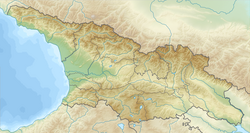Upper Svaneti
|
Svaneti სვანეთი |
|
|---|---|
| Historical Region | |
 The historic region of Svaneti in Georgia |
|
| Country |
|
| Mkhare |
Racha-Lechkhumi and Kvemo Svaneti Samegrelo-Zemo Svaneti |
| Capital | Mestia, Lentekhi |
| Area | |
| • Total | 5,776.4 km2 (2,230.3 sq mi) |
| Population | |
| • Total | 23,000 |
| • Density | 4.0/km2 (10/sq mi) |
 |
|
| UNESCO World Heritage Site | |
|---|---|
| Location |
Georgia |
| Criteria | iv, v |
| Reference | 709 |
| Coordinates | 42°54′59″N 43°00′41″E / 42.916388888889°N 43.011388888889°E |
| Inscription | 1996 (20th Session) |
|
[]
|
|
Svaneti or Svanetia (Suania in ancient sources) (Georgian: სვანეთი Svaneti) is a historic province in Georgia, in the northwestern part of the country. It is inhabited by the Svans, an ethnic subgroup of Georgians.
![]() = Upper Svaneti
= Upper Svaneti ![]() = Lower Svaneti
= Lower Svaneti
Situated on the southern slopes of the central Caucasus Mountains and surrounded by 3,000–5,000 meter peaks, Svaneti is the highest inhabited area in the Caucasus. Four of the 10 highest peaks of the Caucasus are located in the region. The highest mountain in Georgia, Mount Shkhara at 5,201 meters (17,059 feet), is located in the province. Prominent peaks include Tetnuldi (4,974 m / 16,319 ft), Shota Rustaveli (4,960 m / 16,273 ft), Mount Ushba (4,710 m / 15,453 ft), Ailama (4,525 m / 14,842 ft), as well as Lalveri, Latsga and others.
Svaneti has two parts corresponding to two inhabited valleys:
They are separated by the Svaneti Range which is almost as high as the main Caucasus range. Historical Svaneti also included the Kodori Gorge in the adjoining rebel province of Abkhazia, and part of the adjacent river valleys of Kuban and Baksan north of the crest of the Caucasus. Writing in 1848, Bodenstedt said that Upper Svaneti could only be reached by a difficult footpath which was closed in winter.
...
Wikipedia

